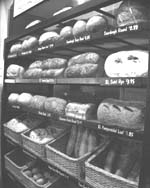|
Thursday,
October 25, 2001
A
slice of heaven
By
Kristin Campbell
Staff Reporter
The Israelites
ate a version of it every day for 40 years while they journeyed
through the desert. It has formed the main part of the average
person’s diet for centuries.
Baking
companies are solely devoted to its production.
Bread
has been a staple food for years and it’s popularity
will never die for several reasons. To name a few, bread is
the base of the food pyramid and is available in seemingly
endless varieties.
History
According
to www.PageWise.com, bread dates back at least 4,000 years.
Egyptian workers were often paid in loaves of bread and paintings
in the pyramids show the dead were buried with loaves of bread
to provide sustenance in the afterlife.
Greek
merchants brought Egyptian flour to Greece, and bread-baking
flourished.
After
Rome conquered Greece and took over the bread industry, the
first Baker’s Guild was formed in 150 B.C.
According
to www.history-magazine.com, bread was subject to special
laws because it was so vital to peoples’ lives. The site
reported that as early as medieval times, bakers were subject
to regulations in order to protect the consumer.
Bread
took another variation during America. Cornbread was invented
in the early days of colonial America as an easy substitute
for more traditional bread, since corn was easy to grow and
harvest, but wheat and millers were not readily available.
Flour
mills became popular in the 1800s, which led to an increase
of highly-processed flour and the production of white bread,
which is less nutritious, PageWise.com
reported.
Baking
Process
Different
types of bread undergo specific baking procedures.
Breadworks
Flour Mill and Baking Company, on 5837 Camp Bowie Boulevard,
specializes in soft-crust American hearth breads and offers
a variety of breads, cookies, muffins, cinnamon rolls and
sandwiches.
Renay
Roark, Breadworks owner, said he makes bread the old-fashioned
way by starting with commercial yeast, which is not powdered.
First he crumbles the yeast into water, which turns the mixture
into a sponge. After it sits for one hour, freash-ground grains
from a stone mill are added by hand until the sponge reaches
the right consistency.
Roark
said the dough is then hand-rolled, kneaded and broken into
two-pound sections. Yeast makes dough rise during a time called
“proofing.”
 |
|
Kristin
Campbell/SKIFF STAFF
Panera Bread offers many varieties of bread that are
baked fresh daily in-house.
|
“We
use a sophisticated eyeball to get the bread just right,”
Roark said. “We make the bread all by hand and eyesight,
very much like your grandmother would,” he said.
The dough
is placed in pans and baked in 330-degree ovens. Roark said
he sprays water on French bread, which is baked at 450 degrees,
to make the crust crunchy.
Bread
made without preservatives should stay fresh for about a week
if stored at room temperature, he said. Refrigerating dries
the bread out faster.
Kevin
Brown, executive director at Panera Bread, said total preparation
and baking time for bread exceeds 24 hours.
To make
sourdough, the dough sits for at least 20 hours, he said.
The dough is placed in molds and sits for at least three hours
to allow the yeast to rise. The dough is then baked for an
hour at 350 to 420 degrees.
Brown
described baking as an enjoyable art.
“I
can’t bake nearly as well as my bakers can,” Brown
said. “Timing, feel and knowing how your oven bakes are
constant variables.”
Nutritional
Value
Contrary
to a popular myth, bread is not fattening.
According
to the Web site www.Woolworth.com, this idea developed as
a result of recent diets that told people to avoid carbohydrate
foods, especially bread. Without carbohydrates, the body temporarily
loses some of its normal water and results in weight loss,
the site said. However, when the body’s normal water
supply is replenished, the weight also returns.
Jessica
Moore, a junior history and political science major, said
she eats what she wants and exercises to prevent weight gain.
Everyone ought to allow themselves to eat food they enjoy,
she said.
“People
who are on no-carb diets annoy me,” Moore said. “I
don’t know how they can survive without bread.”
Woolworth.com
also reported that bread is a source of starch, complex carbohydrates,
B vitamins and dietary fiber.
Mary
Anne Gorman, a professor of nutrition and dietetics, said
that although bread is a low-fat food, the butter, oils and
toppings people add make it fatty.
“Whole
grain breads are the best sources for nutrients and produce
numerous health benefits,” Gorman said.
She said
carbohydrates should comprise 58 percent of your daily food
intake.
The American
Dietetics Association advises that at least six to 11 daily
servings of grains be from whole grains.
Mrs.
Baird’s Web site reported that the whole wheat bread
is comprised of the entire kernel — the bran, germ and
endosperm. White bread is milled from only the endosperm.
Whole wheat bread contains four times as much fiber as white
bread, the site said.
Since
nutrients are removed when the husk falls off, Roark said,
white bread is not good for you.
“Bleached,
enriched white bread might as well be ground cardboard,”
Roark said. “It’s easy to make bread look good but
it’s harder to make it taste good.”
Brown
said sourdough, which is the base for 80 percent of Panera’s
breads, has no added fat.
Rye and
nine-grain breads are also very low in fat, but cinnamon raisin
bread has the highest fat content.
Varieties
and Popularity
Moore,
a server at Pappadeaux Seafood Kitchen, said she has customers
who get cranky when she forgot to bring the complimentary
bread to their table before the meal arrived.
“They
complained because I forgot to ask if they wanted bread,”
she said.
Moore
said she loves bread, especially cinnamon raisin.
“I’m
a carb addict,” Moore said. “God gave me the taste
buds for bread.”
Kristin Campbell
k.a.campbell@student.tcu.edu
|

